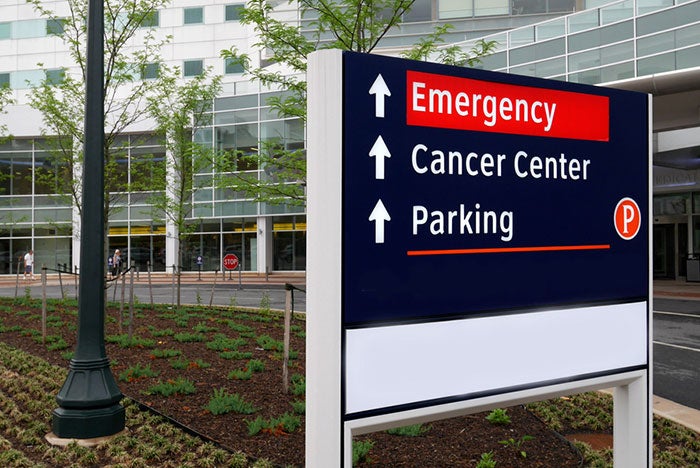Intelligent system considerations

Visible signage throughout a hospital camps allows occupants to more easily navigate through the multiple facilities.
Photo credit: Peter Spiro
Infrastructure can play an integral role in health care facilities, where patient satisfaction and healing are top priorities. Health care leaders can choose intelligent infrastructure to create healthier, better outcomes for patients and their families.
In the unfortunate event of an emergency or natural disaster, this same (and in some cases added) infrastructure can be utilized to improve the safety of all occupants within a health care facility, from staff who know their way around the facility to patients and visitors who are likely not as familiar with the building and its exit and entry points.
Fueling a healthy environment
Health care facilities typically have an extensive list of initiatives they must support, from medical programs to research advancements, to patient success and satisfaction. In order to keep up with these tasks, leveraging technology and infrastructure is a great place to start.
St. Jude Children's Research Hospital is a great example of an institution that is juggling many different priorities. St. Jude’s campus comprises 66 acres with more than 5-million-square-feet of building space. Naturally, operating and maintaining these facilities can be a daunting challenge, especially while also keeping the proper environment for health care and research in mind.
Many other hospitals are also set on large campuses, enabling them to operate like cities in and of themselves. This makes it imperative to implement technology, like visible signage, throughout the campus to allow occupants to more easily navigate through the multiple facilities. This is especially helpful for staff who need to move around efficiently to spend more time caring for their patients.
Much of the advanced technology available today, especially as it relates to innovation and integration, can allow patients to create a personalized environment and is essential to patient experience. Lighting, for example, allows patients to control their own environment for optimal comfort and improved healing, while lighting in operating rooms can drastically improve staff efficiency. Temperature and humidity control, when integrated with HVAC systems, allow patients personal control over the climate in their room.
Planning for the worst
Natural disasters and other emergencies, such as an active shooter, necessitate increased planning and investment in technology and infrastructure upgrades that enable health care facilities to act quickly during an event and bounce back more effectively after.
During an emergency, smart lighting systems can improve the safety and security of patients, their families and health care staff. For example, if there is an intruder, all lights can be programmed to turn blue, signifying to shelter in place. Additionally, mass notification and addressable notification systems allow a universal message, or individual messages to be tailored to specific areas, buildings, floors or rooms. This capability allows certain floors to evacuate while others defend in place, depending on the situation and safest escape route.
Health care facilities have enough to worry about. Getting back on their feet after an emergency shouldn’t be one of them. Distributed energy storage can help by releasing stored energy to provide power during an outage, which is critical for always-occupied health care environments where patients count on power to keep them healthy, safe and comfortable. Video surveillance can also help health care facilities keep an eye on high trafficked locations, helping to investigate stolen or damaged items, along with visitor or patient complaints.
These intelligent infrastructure considerations are key to health care facilities staying operational and resilient before, during and after an emergency. With patient needs, staff efficiencies, code compliance and more always on the minds of health care leaders, infrastructure can be the helpful backbone they need to succeed.
Renée R. Jacobs, CHFM, CHC, SASHE, is enterprise strategic account manager for Johnson Controls. She can be reached at Renee.R.Jacobs@jci.com.




